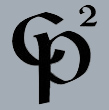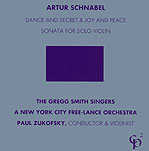
DANCE AND SECRET & JOY AND PEACE
SONATA FOR SOLO VIOLIN
Paul Zukofsky
Conductor and Violinist
THE GREGG SMITH SINGERS
A NEW YORK CITY FREE-LANCE ORCHESTRA

 |
ARTUR SCHNABEL DANCE AND SECRET & JOY AND PEACE SONATA FOR SOLO VIOLIN Paul Zukofsky Conductor and Violinist THE GREGG SMITH SINGERS A NEW YORK CITY FREE-LANCE ORCHESTRA |
 |
ARTUR SCHNABEL (1882-1951) wrote his Dance and Secret & Joy and Peace in 1944. In the chronology of Schnabel's compositions these two works for chorus and orchestra follow directly after Symphony No. 2 (CP2104). The genesis of these choral works, and the impetus which gave rise to them, is best described by quotations from three Schnabel letters, written from Gascon Ranch, New Mexico, and addressed to Mary Virginia Foreman. Some introductory comments are, however, in order. The Robert Frost poem of Dance and Secret is "The Secret Sits" "We dance round in a ring and suppose, which first appeared April, 19361. Of particular interest to me is Schnabel's word distribution over time, with words 3-6 of line 1 not entering until approximately 2 ½ minutes into the work; words 7 and 8 entering until approximately 3 ½ minutes; and the second line finally appearing (rather straightforwardly) at approximately 5 ½ minutes. This temporal expansion of the poem is in direct contrast to the textual contraction used in Joy and Peace. That text is extracted from Isaiah chapter 55 and the first verse of chapter 60, and it behooves the reader to compare the original (i.e. King James) Isaiah with Schnabel's "selection," so as to observe the wondrous choices used to transform one of the more thunderous Prophets into something consummately lyrical. The letter excerpts follow. Note that I have revised the letter's quoted Isaiah text (which tends to follow the King James) so as to conform to the actual words sung by the chorus. I have also taken the liberty of parsing the text into 6 paragraphs congruent with the main choral segments. Gascon Ranch, New Mexico, August 6, 1944: "In a few days I shall approach the “We dance, it sits'” Choral Symphony. In my mind since New York days, as you know, Frost's two lines were incessantly boring. They have now succeeded to force me into the experiment to produce a big piece of music with, and around, these few words which, in my opinion are not only particularly well-suited, but absolutely sufficient for music—Dance, Round, Guess, Secret; Surface and Gist." August 28: "Dance and Secret is almost finished, though not yet orchestrated. I learned a lot. The two bodies of chorus and orchestra are almost opposites. The human voice is, by comparison very limited in range, speed, and endurance. In writing for 4 or 6 voices it must not be too polytonal or polymelodic, or polyrhythmical. For such functions voices are not sufficiently independent. There is scarcely any 'dissonant' literature for choruses. The voices would automatically, if not specially trained for years, incline towards the usual harmonies, and the result of such arbitrariness would, of course, be disastrous for the music as it was intended to sound. My music is polymelodic, rhythmical, and tonal. I tried a compromise, made it as singable for the singer's ears, not their larynxes — as possible, rather like chamber music with symphonic sonorities. The parts that the Orchestra has alone are then an intended contrast, all frictions permitted. When the Orchestra sounds together with the singers, it is mostly kept as high or low as the voices can reach. The piece is partly dark and fierce, but the sweet secret is; comfort, refuge from idleness of pretensions and illusions, almost as if Truth was that which we do not know. (We certainly know better what 'lie' is.)" September 2, 1944: "I started writing another piece for chorus and orchestra. It is meant to be a sharp contrast and thus a necessary completion of the first one; they are, for me, inseparable in the order I made them. Frost's two lines express that man's possible knowledge is limited to mere guess-work. They do, however, by no means deny the existence of human reason. It is, actually, this reason which shows them the limit. The second piece has a Biblical text. The words are taken, selected and arranged, from the book for the second Isaiah. They express that faith is more than knowledge. Faith is absolute, and beyond change. It is no abstraction; one has it, as one has reason. Combined faith and reason lead the individual to a productive acceptance of life and of destructive forces even, which have to be fought in one's own system of impulses. The words are: 'Every one who thirsteth, come ye to the waters! That was long before the 19th century! It holds." "I have, today [September 7] finished; it requires only elaboration, ornamentation, instrumentation—this second of my choral pieces. I think it has the adequate atmosphere as far as this is possible. Joy and Peace can, of course, appear in numerous expressions, in exactly opposite ones. A Biblical text sung by a group, ought to get some rather generalized, super-personal, tho not conventional, collective exhaltation and yet [be] valid and convincing for every individual. It ought to be representative, including simply, the human. To work on it attracted me immensely— The instrumentation for the handmade playthings has to be added— The pieces can presumably not be sight-read, but are, also, not forbidding." It is a pleasure to acknowledge Gregg Smith's help in preparing the chorus. He is a valuable and valued colleague. Last, but by no means least, Musical Observations and I gratefully acknowledge the extraordinary assistance provided this recording, as well as those of Schnabel's Symphonies 1, 2, & 3, by Mary Virginia Foreman Le Garrec. In all probability, without her existence, none of this would ever have been possible. We are greatly in her debt.
|
||||||||||||||||||||||||
| TRACK LISTING |
|
| DANCE AND SECRET & JOY AND PEACE [TWO PIECES FOR CHORUS AND ORCHESTRA] |
|
| 1. Dance and Secret | (12:16) |
| 2. Joy and Peace | (10:39) |
| Time = 23:03 THE GREGG SMITH SINGERS GREGG SMITH, ARTISTIC DIRECTOR A NEW YORK CITY FREE-LANCE ORCHESTRA PAUL ZUKOFSKY, conductor |
|
| SONATA FOR SOLO VIOLIN |
|
| 3. I. Langsam, sehr frei und leidenschaftlich | (9:36) |
| 4. II. In kräftig-frölichem Wanderschritt durchweg sehr lebendig | (2:24) |
| 5. III. Zart und anmutig, durchaus ruhig | (13:00) |
| 6. IV. Äusserst rasch (Prestissimo) | (5:50) |
| 7. V. Sehr langsame Halbe, mit feierlichem ernstem Ausdruck, doch stets schlicht | (16:41) |
Time = 46:56 PAUL ZUKOFSKY, violin TOTAL TIME = 71:27 |
|
Dance and Secret & Joy and Peace by Artur Schnabel
were recorded February, 1993 at BMG (originally RCA) Studio A, New York City.
Producer: Joanna Nickrenz
Sound Engineer: Jay Newland
Montage: PZ, with Elite Recordings, New York City
Mastering: Soundbyte Productions, New York City
Sonata for Solo Violin by Artur Schnabel was recorded June 13 and 21, 1983 at Rutgers Church, New York City.
Producer: Marc Aubort/Joanna Nickrenz
Sound Engineer: Elite Recordings, New York City
Montage: PZ, with Elite Recordings, New York City
Mastering: Soundbyte Productions, New York City
1"The Secret Sits" from THE POETRY OF ROBERT FROST, edited by Edward
Connery Lathem. Copyright 1942 by Robert Frost, ©1969 by Henry Holt and Co.,
©1970 by Lesley Frost Ballantine. Recorded by arrangement with the Estate of
Robert Frost and Henry Holt and Co., New York.
CP2110
© 1996 Musical Observations, Inc.
Warning: Copyright subsists in all recordings issued under this label.